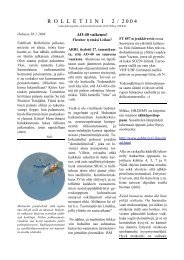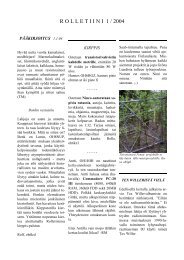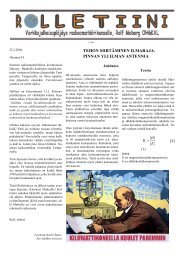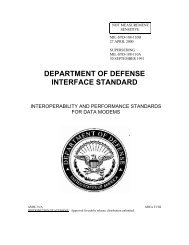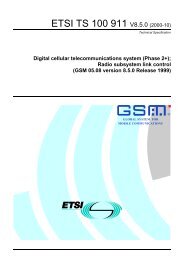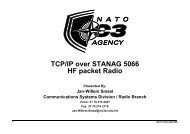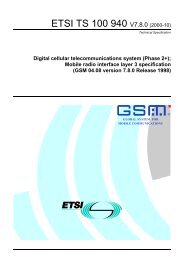nato unclassified - Ham-pages ... No indexes at this level
nato unclassified - Ham-pages ... No indexes at this level
nato unclassified - Ham-pages ... No indexes at this level
Create successful ePaper yourself
Turn your PDF publications into a flip-book with our unique Google optimized e-Paper software.
NATO UNCLASSIFIED<br />
STANAG 5066: PROFILE FOR MARITIME HF DATA COMMUNICATION<br />
V1.0.2<br />
Annex B: Channel Access Sublayer<br />
(mand<strong>at</strong>ory)<br />
The functions required of the channel access sublayer are quite limited in the ship-shore<br />
applic<strong>at</strong>ion.<br />
B.1 Channel Access Sublayer Service Definition<br />
The Channel Access Sublayer provides services to the Subnetwork Interface Sublayer. These<br />
services are:<br />
1. Execute Physical Link “Make and Break” requests.<br />
2. <strong>No</strong>tify changes in the st<strong>at</strong>e of the Physical Link.<br />
3. Accept S_PDUs (in the appropri<strong>at</strong>e primitive) for transmission.<br />
4. Deliver received S_PDUs (in the appropri<strong>at</strong>e primitive).<br />
In order to provide these services, the Channel Access Sublayer implements a protocol which<br />
specifies the tasks th<strong>at</strong> must be executed and the rules th<strong>at</strong> must be obeyed by the sublayer.<br />
While a number of different channel access protocols are possible, the one th<strong>at</strong> is suitable for<br />
<strong>this</strong> document is referred to as the type 1 protocol.<br />
B.2 Channel Access Protocol Type 1 and C_PDUs<br />
The Type 1 Channel Access Protocol supports the following subnetwork configur<strong>at</strong>ion:<br />
1. Pairs of <strong>No</strong>des are linked “point-to-point” on a “common” HF frequency channel or on<br />
dedic<strong>at</strong>ed frequency channels selected from a pool of assigned frequencies by an external<br />
process 5 which is not under the control of any of the sublayers (an ALE sublayer is not<br />
present or not used).<br />
2. The co-ordin<strong>at</strong>ion of the making and breaking of Physical Links between two nodes<br />
(after a common frequency has already been selected by an external process) is<br />
performed solely by the Channel Access Sublayer.<br />
3. The <strong>No</strong>des may or may not be within ground-wave distances.<br />
B.2.1<br />
Type 1 Channel Access Sublayer Peer-to-Peer Communic<strong>at</strong>ion<br />
The type 1 Channel Access Sublayer communic<strong>at</strong>es with peer sublayers in other nodes in<br />
order to:<br />
1. Make and break physical links<br />
2. Exchange S_PDUs submitted by the Subnetwork Interface Sublayer.<br />
5 An appropri<strong>at</strong>e frequency may be simply selected manually by an oper<strong>at</strong>or or by an external<br />
(semi)autom<strong>at</strong>ed process e.g. “available” frequencies are negoti<strong>at</strong>ed between a node which needs to<br />
establish a link and a master st<strong>at</strong>ion which “manages” the assigned frequency pool. Protocol type 1<br />
provides no mechanism for autom<strong>at</strong>ic interaction between the external process and the Channel Access<br />
Sublayer. The Channel Access Sublayer “assumes” th<strong>at</strong> a common frequency channel has already been<br />
found.<br />
NATO UNCLASSIFIED<br />
1




